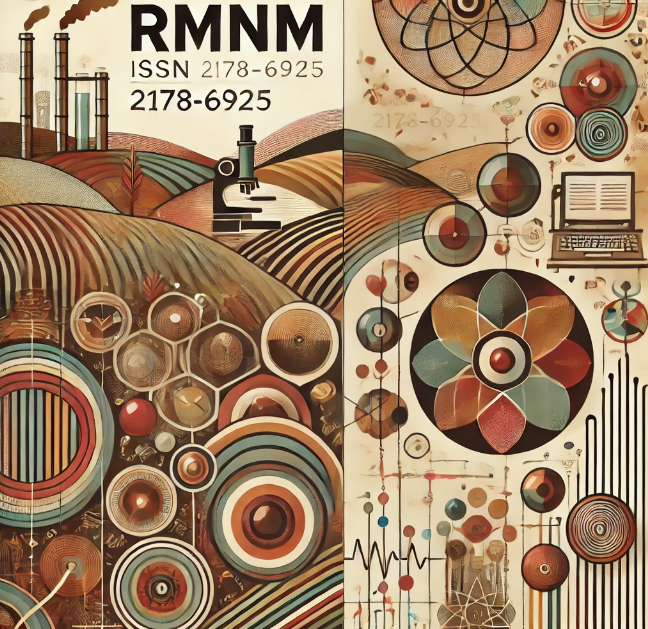Determination of nitrogen compounds in water for human consumption in the municipality of Itacoatiara-Am using methodologies based on digital images.
DOI:
https://doi.org/10.61164/rmnm.v4i1.2285Keywords:
Digital image colorimetry, UV-Vis spectrophotometry, Water analysis.Abstract
Nitrogen compounds: nitrate (NO3-), nitrite (NO2-) and ammonia (NH3), when in excess in water, make it unfit for consumption. Ingestion of water contaminated by these compounds causes diseases such as: methemoglobin, breast cancer, stomach, breast cancer and bladder cancer. Ammonia is easily adsorbed on soil particles and is generally found in groundwater or shallow water. The presence of ammonia is important in the method of disinfecting water using chlorine, through the formation of chloramines, which have low bactericidal power. Excess nitrite in water presents a health hazard, as it can cause methemoglobinemia in newborns and even adults with enzyme deficiency. Nitrate is capable of being converted to nitrite by the action of some enzymes in saliva and specific bacteria according to the reaction. Nitrite, nitrate and ammonia can be determined by UV-Vis spectrophotometry. In this project, a study of the nitrite, nitrate and ammonia content in water for human consumption was proposed using methodologies based on digital images. The water quality parameters analyzed were: nitrite, nitrate and ammonia, both with the developed photometer and with the reference method, UV-VIS spectrophotometry. The results obtained by the two methodologies present a small discrepancy with an absolute relative error of 6.0%. All samples presented nitrite, nitrate and ammonium levels below the maximum value allowed by Ordinance No. 888/2021 of the Ministry of Health for drinking water.
References
AMERICAN PUBLIC HEALTH ASSOCIATION (APHA). Standard methods for the examination of water and wastewater. 17a ed. Washington, 1992. p.4-75/ 4-93.
ANTUNES, V. L. M. Análise de Amoníaco em Águas Utilizando um Sensor Acústico, 2010.
ARMSTRONG, F.A.J. Determination of nitrate in water by ultraviolet spectrophotometry. Anal. Chem. 35: p 1292 -1294. 1963. DOI: https://doi.org/10.1021/ac60202a036
AYDINDOGAN, CEYLAN, TIMUR. Based colorimetric spot test utilizing smartphone sensing for detection of biomarkers. Talanta, v. 208, 2020. DOI: https://doi.org/10.1016/j.talanta.2019.120446
BABKO, A. K.; PILIPENKO Photometric Analysis: Methods of Determining Non-Metals. Moscou: Mir Publishers 1976. 374p. (1974).
BAIRD, C. Química Ambiental. 4ª ed., Porto Alegre: Bookman, 2011.
BATALHA, B.H.L. et al. Controle da qualidade da água para consumo humano: bases conceituais e operacionais. São Paulo, CETESB, 1993.
BRASIL, Ministério da Saúde (MS), Portaria nº 888, de 04 de maio de 2021. Brasília, 2021.
BRASIL. Ministério da Saúde. Portaria n° 518 de 25 de março de 2004. Estabelece os procedimentos e responsabilidades relativos ao controle e vigilância da qualidade da água para consumo humano e seu padrão de potabilidade, e dá outras providências. Diário Oficial da República Federativa do Brasil, Brasília. 26 de março de 2004, p. 266-270.
BRASIL, Ministério do Meio Ambiente (MMA), CONAMA, Resolução Nº 357, de 17 de março de 2005. Brasília, 2005.
CESTEB, Divisão de Toxicologia Humana e Saúde Ambiental: Nitrito e Nitrato, de 22 de dezembro de 2022.
C. SHEN, S. LIOU, Surface acoustic wave gas monitor for ppm ammonia detection, Sens. Actuators B 131(2008) 673-679 DOI: https://doi.org/10.1016/j.snb.2007.12.061
CUSTÓDIO, E. & LLAMAS, M. R. Hidrologia Subterrânea. Ediciones Omega (I e II): Barcelona, 1983, 2359p.
CHAGAS, A. P.; As ferramentas do químico. Quím. Nova na Escola. n. 5, p. 18-20, 1997.
ECYCLE. Alimentação: Nitrito e Nitrato. Disponível em: https://www.ecycle.com.br/nitrito-e-nitrato/.
ESTEVES, F. D. (1998). Fundamentos de limnologia. Interciência(2ª), 602.
FONSECA, A. Determinação do Índice de Nitrato, Nitrito e Nitrogênio Amoniacal na Água da Lagoa de Extremos/RN. Universidade Federal do Rio Grande do Norte, 2017.
GALAL-GORCHEV, H. et al. Revision of the WHO guidelines for drinking water quality. Ann Ist Super Sanita, v.29, n.2, 1993. p.335-345.
J. A. TETLOW AND A. L. WILSON, An Absorption Method for Determining Ammonia in Boiler Feed-water, Analyst 89(1964) 453-465. DOI: https://doi.org/10.1039/an9648900453
MATO, A. P. Determinação de nitratos, nitritos e prováveis fontes de contaminação em águas de poços e sua influência na metemoglobinemia infantil. São Paulo, 1996. [Dissertação de Mestrado - Curso de Pós-Graduação em Saneamento Ambiental, Universidade Mackenzie].
ORGANIZAÇÃO MUNDIAL DA SAÚDE. Agência Internacional de Pesquisa sobre o Câncer, 2020.
PLÁCIDO, Katharina. UNIVERSIDADE DE BRASÍLIA: Avaliação Do Uso De Imagens Digitais Obtidas Por Smartphones Para Determinação De Amônia Total Em Águas, 2017.
POLÍTICA NACIONAL DOS RECURSOS HÍDRICOS, Lei n.º 9433, 08 de janeiro de 1997.
RESENDE, A. V. de. Agricultura e Qualidade da água: Contaminação da água por nitrato. Planaltina, DF: Embrapa Cerrados. Dez, 2002.
REIS, J. A., & MENDONÇA, A. S. (s.d.). Teores limites para compostos amoniacais em efluentes e corpos receptores - conflitos e interrelações. Associação Brasileira de Engenharia Sanitária e Ambiental - ABES, 6, 1965-1974.
RIGUETO, YOHANA. Determinação De Ferro Em Água Fluvial Na Bacia Do Córrego Sujo – Teresópolis Por Espectrofotometria De Absorção Molecular No UV-Vis, 2014.
SEBRANEK, J.G. & CASSENS, R.G. Nitrosamines: a review. J. Milk Fd Technool., 36: 76-91, 1973. DOI: https://doi.org/10.4315/0022-2747-36.2.76
TELLES, D. A, COSTA, R. H. P. G. Reuso da água: conceitos, teorias e práticas. 1. ed. São Paulo: Blucher, 2007.
VIEGA, SARA. Qual a melhor forma de tomar um suplemento de ferro. 2016.
Downloads
Published
How to Cite
Issue
Section
License
Copyright (c) 2024 Revista Multidisciplinar do Nordeste Mineiro

This work is licensed under a Creative Commons Attribution-NonCommercial-ShareAlike 4.0 International License.




